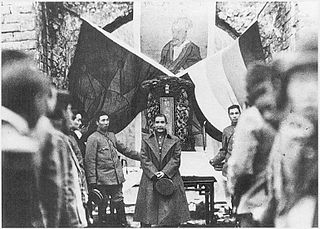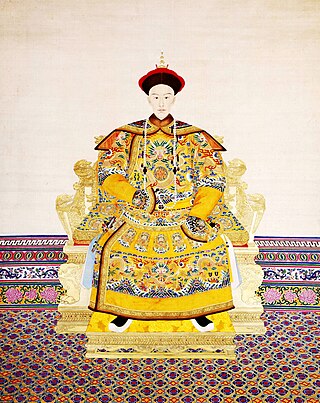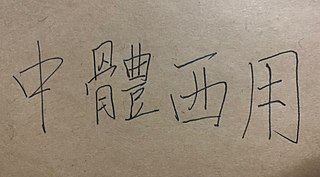Related Research Articles
Written vernacular Chinese, also known as baihua, comprises forms of written Chinese based on the vernacular varieties of the language spoken throughout China. It is contrasted with Literary Chinese, which was the predominant written form of the language in imperial China until the early 20th century.

Han nationalism is a form of ethnic nationalism asserting ethnically Han people as the exclusive constituents of the Chinese nation. It is often in dialogue with other conceptions of Chinese nationalism, often mutually-exclusive or otherwise contradictory ones. Han people are the dominant ethnic group in both states claiming to represent the Chinese nation: the Republic of China and the People's Republic of China.

New Confucianism is an intellectual movement of Confucianism that began in the early 20th century in Republican China, and further developed in post-Mao era contemporary China. It primarily developed during the May Fourth Movement. It is deeply influenced by, but not identical with, the neo-Confucianism of the Song and Ming dynasties.
Westernization, also Europeanisation or occidentalization, is a process whereby societies come under or adopt what is considered to be Western culture, in areas such as industry, technology, science, education, politics, economics, lifestyle, law, norms, mores, customs, traditions, values, mentality, perceptions, diet, clothing, language, writing system, religion, and philosophy. During colonialism it often involved the spread of Christianity. A related concept is Northernization, which is the consolidation or influence of the Global North.

Hanfu Movement, also known as the Hanfu Revival Movement, is a homegrown, grassroots cultural movement seeking to revive or revitalize Han Chinese fashion. It finds its manifestation in the wearing in public of the traditional Han attire of pre-Qing era. It began as the elegant pastime of a historically-conscious subculture and has evolved into a trendy nationwide movement boasting millions of young consumers and led by fashion-conscious youth. It has also slowly gained traction amongst the overseas Chinese diaspora, especially in countries like Singapore.
Essence-function is a key concept in Chinese philosophy and East Asian Buddhism. It is a compound of two terms: "essence", the absolute reality, cause, or source of all things, and "function", the manifestations of ti, which make up the impermanent and relative concrete reality. Ti and yong do not represent two separate things, but aspects of the same non-dual process.
Pan Pingge, was a notable Chinese philosopher during the late-Ming and early-Qing period.
Angelo Zottoli was an Italian Catholic priest and missionary in China and a sinologist.

The history of the missions of the Jesuits in China is part of the history of relations between China and the Western world. The missionary efforts and other work of the Society of Jesus, or Jesuits, between the 16th and 17th century played a significant role in continuing the transmission of knowledge, science, and culture between China and the West, and influenced Christian culture in Chinese society today.
The New Qing History is a historiographical school that gained prominence in the United States in the mid-1990s by offering a major revision of history of the Manchu-led Qing dynasty of China.

The Far West is a Chinese and Japanese term for Europe, or more broadly, for the entire Western world as a cultural region comparable to East Asian cultural sphere. Originally a name for parts of Inner Asia and India, the term Far West as a Chinese exonym for the West was coined by the Italian Jesuit priest Matteo Ricci. Ricci invented the phrase as an Asian parallel to the Eurocentric notion of the Far East, which positioned Europe as a region on the fringes of a Sinocentric world. The term Far West was also used in Japan and appears in many Japanese publications.
Political theology in China refers to the religious beliefs and principles that motivate the politics of China. For two millennia, China was organized on a Confucian understanding of religion and politics, often discussed in terms of Confucian political philosophy. At various points throughout its history, Chinese Buddhism presented an alternative to the political import of Confucianism. However, since the mid-twentieth century, communist understandings of religion have dominated the discourse.

The Sinicization of the Manchus was the process in which the Manchu people became assimilated into the Han-dominated Chinese society. It occurred most prominently during the Qing dynasty when the new Manchu rulers actively attempted to assimilate themselves and their people with the Han to increase the legitimacy of the new dynasty. As a result, when the Qing dynasty fell, many Manchu had already adopted Han Chinese customs, languages and surnames. For example, some descendants of the ruling imperial House of Aisin-Gioro adopted the Han Chinese surname Jin as both Jin and Aisin mean gold.

The idea of "Chinese Learning as Substance, Western Learning for Application" was initially proposed by Feng Guifen in his Xiaopinlu kangyi, written in 1861 after the Second Opium War. At the time, leading Chinese thinkers were interrogating how to approach the threat posed by encroaching Western states. Feng argued for China's self-strengthening and industrialization by borrowing Western technology and military systems, while retaining core Neo-Confucian principles. These ideas were further elaborated on by Zhang Zhidong in 1898 in his book Quanxue pian as "Traditional (Chinese) learning as substance, New (Western) learning as application" (“舊學為體,新學為用”). “Zhongti xiyong” became a popular slogan used in the late Qing Reforms, including the Self-Strengthening Movement and Hundred Days' Reform. The concept was widespread among intellectuals in the late 19th and early 20th century, and it remains relevant in the modern studies of China-West cultural relationship.
Fang Keli was a Chinese New Confucian philosopher and a member of the Chinese Communist Party. He was best known for his work in New Confucianism and his theories which attempt to fusion Marxism and Chinese culture.

Ye Xiushan was a Chinese philosopher, aestheticist and Chinese Opera theorist. Ye was one of the first Faculty Scholars at the Chinese Academy of Social Sciences (CASS), a Member of the Chinese Academy of Social Sciences, and a member of the 8th, the 9th and the 10th National Committee of the Chinese People's Political Consultative Conference as an independent scholar.

Chinese Islamic architecture, Sino-Islamic architecture, or Islamic architecture of China are terms used to indicate the architectural tradition and cultural heritage of the Muslim populations in China, both of mainland and outer China, which has existed since the 8th century CE to the present. With the acculturation of the Islamic religion within the predominant Han-Chinese culture, a unique architectural style emerged among Chinese Muslims. It became standard for them to incorporate traditional Chinese and Islamic architectural elements together for mosques, prayer halls, mausoleums, and other buildings.
Willard J. Peterson is an American historian and sinologist. He is Gordon Wu '58 Professor of Chinese Studies, Emeritus, and Professor of East Asian Studies and History, Emeritus at Princeton University. His research specialties include early Chinese philosophy and Chinese intellectual history and history of science during the Ming and Qing dynasties.
In China, Industrial Party refers to a group of Chinese thinkers and Chinese people who support scientific thinking, advanced technology, techno-nationalism, and economic growth, but reject liberalism, universal values, and free market. In a narrow sense, it could also refer to the fan culture of Illumine Lingao, a Chinese time-travel novel.
The east-west cultural debate is a debate on the similarities and differences, the strengths and weaknesses, and the trade-offs between Eastern culture and Western culture during the mainland period of the Republic of China. This debate began with the founding of the New Youth magazine in 1915 and ended before the Northern Expedition in 1927. During this period, hundreds of people participated in the debate with over a thousand articles, focusing on Chinese culture and Chinese society.
References
- ↑ Liu, Dachun (2018). Western Learning Spreads Eastward (in Simplified Chinese). Beijing: China Renmin University Press. ISBN 978-7-300-26325-0. OCLC 1089442491.
- ↑ Kuang, Shuping (2016-09-21). "Eastward Transmission of Western Learning and the Evolution of Modern Sports in Shanghai, 1843–1949". The International Journal of the History of Sport. 33 (14): 1606–1625. doi:10.1080/09523367.2017.1288106. ISSN 0952-3367. S2CID 152205041.
- ↑ Koerbs, Christoph (2008), "East and West: China in the Transmission of Knowledge from East to West", in Selin, Helaine (ed.), Encyclopaedia of the History of Science, Technology, and Medicine in Non-Western Cultures, Dordrecht: Springer Netherlands, pp. 712–717, doi:10.1007/978-1-4020-4425-0_9121, ISBN 978-1-4020-4425-0 , retrieved 2022-06-14
- 1 2 Xiong, Yuezhi (2013). The eastward dissemination of western learning in the late Qing dynasty . Volume 1. Singapore: Silkroad Press. ISBN 978-981-4332-79-8. OCLC 834558621.
- ↑ Yung, Wing (1973). 西学东渐记 (in Traditional Chinese). Taipei: Wen Hai Press Company. OCLC 23471698.
- ↑ Lu, Di (2017). ""西学东渐"一词始于清末而非民初". China Terminology (1).
- 1 2 Li, Yining (2016-05-06). "新文化运动与西学东渐". Guangming Daily – via Peking University.
- ↑ Cheng, Anne (2014). "Philosophy and the French Invention of Sinology: Mapping Academic Disciplines in Nineteenth Century Europe". China Report. 50 (1): 11–30. doi:10.1177/0009445513516533. ISSN 0009-4455. S2CID 142991146.
- ↑ Zhao, Yunze; Sun, Ping (2018-05-11). A History of Journalism and Communication in China. Routledge. ISBN 978-1-317-51931-7.
- 1 2 3 Lin, Li-Nan; Yang, Yong-Bo (2008). "The Gradual Spread of Western Learning to China and the Change in Practical Education Trend during the Period of Late Ming and Early Qing". Journal of Shenyang Normal University (Social Science Edition). 32 (5): 118–122. doi:10.3969/j.issn.1674-5450.2008.05.032.
- ↑ Carter, James (2021-02-10). "The Yongzheng Emperor and Christianity in China". SupChina. Retrieved 2022-06-14.
- ↑ Lin, Ren-Jie Vincent (2016-10-14). "Eastward Expansion of Western Learning: A study of Westernisation of China's modern education by Chinese government overseas-study scholarships". Educational Philosophy and Theory. 48 (12): 1203–1217. doi:10.1080/00131857.2016.1182462. ISSN 0013-1857. S2CID 147793292.
- ↑ Zhitian, Luo (2019-10-02). "Wholeness and individuality: Revisiting the New Culture Movement, as symbolized by May Fourth". Chinese Studies in History. 52 (3–4): 188–208. doi:10.1080/00094633.2019.1654802. ISSN 0009-4633. S2CID 211429408.
- ↑ Sturniolo, Anthony (2016-08-01). "Influences of Western Philosophy and Educational Thought in China and their Effects on the New Culture Movement". History Theses.
- ↑ Gao, Yang; Tian, Zhaojian (2016). "Philosophical translation in China and its influence on chinese social development in the last century" (PDF). PORTES, Revista mexicana de estudios sobre la Cuenca del Pacífico. 10 (20): 247–268. ISSN 1870-6800.
- ↑ Xinyan, Wang (2013-08-01). "The Eastward Spread of Western Learning and the Sinicization of Marxist Philosophy". Social Sciences in China. 34 (3): 5–19. doi:10.1080/02529203.2013.820553. ISSN 0252-9203. S2CID 145333912.